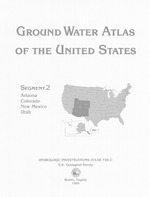Ground Water Atlas of the United States: Segment 2, Arizona, Colorado, New Mexico, Utah
Links
- More information: USGS Index Page (html)
- Document: Report (84.59 MB pdf)
- Larger Work: This publication is Chapter C of Ground Water Atlas of the United States
- Download citation as: RIS | Dublin Core
Abstract
This chapter of the Ground Water Atlas of the United States describes the aquifers in Arizona, Colorado, New Mexico, and Utah. These four States, which comprise Segment 2 of this Atlas, are located in the Southwestern United States and extend from the rolling grasslands of the Great Plains on the east across the Rocky Mountains and Continental Divide to the desert basins of the Southwest. The 425,000-square-mile area ranges in altitude from about 14,400 feet above sea level in the Rocky Mountains of Colorado to about 100 feet near the lower Colorado River in southwestern Arizona. All the ground water in Segment 2 ultimately is derived from infiltration of precipitation, which varies considerably with the altitude and topography of the area.
The Great Plains Physiographic Province of the Central United States extends into eastern Colorado and New Mexico (fig. 1), where flat to rolling prairie (fig. 2) with scattered hills and bluffs gradually rises westward to 5,000 to 7,000 feet above sea level and abruptly gives way to the frontal ranges of the Rocky Mountains in the Southern Rocky Mountain and Basin and Range Physiographic Provinces. West of the frontal ranges in Colorado and northern New Mexico are additional and higher mountain ranges generally oriented north-south but with many spurs and extensions oriented in other directions. The many ranges of the Rocky Mountains are separated by valleys and high mountain parks (fig. 3). Colorado contains about three-fourths of the Nation's land area above 10,000 feet and has 53 mountain peaks higher than 14,000 feet. Most of these high peaks are located near the Continental Divide (fig. 1), which extends approximately north-south through central Colorado and western New Mexico. The altitude of the divide decreases in southern New Mexico to less than 4,500 feet in a few areas.
Farther westward, the mountains are less prevalent and are interspersed with broad structural basins. These basins and the broad valleys of the middle Colorado River and its tributaries form the irregular intermontane topography of the Colorado Plateaus Physiographic Province (fig. 4). Plateaus and high mesas are formed where the surface has been dissected by rugged canyons carved by the Colorado River and its tributaries (fig. 5). The largest of these canyons-the Grand Canyon-extends about 220 miles southwestward from the mouth of the Little Colorado River in Arizona and ranges from 4 to 18 miles in width and from 2,700 to 5,700 feet in depth below the rim.
Small mountain ranges and intervening broad desert valleys of the Basin and Range Physiographic Province are prevalent to the west and south of the Colorado Plateaus in western Utah, southern Arizona, and southern New Mexico (fig. 1). These mountain ranges generally protrude 3,000 to 6,000 feet above the surrounding valley floor (fig. 6) and commonly extend from 20 to 50 miles in a north or northwesterly direction.
Small parts of the Middle Rocky Mountains and Wyoming Basin Physiographic Provinces extend into northwestern Colorado and northeastern Utah (fig. 1). The topography, geology, and hydrology of the two areas are described in Chapter 1 of this Atlas.
Four of the Nation's major river systems have headwaters in the mountainous areas of Segment 2. The South Platte River of the Missouri River system drains the eastern slope of northern Colorado; the Arkansas River and its tributary, the Canadian River, drain southeastern Colorado and northeastern New Mexico; the Rio Grande and its tributary, the Pecos River, drain south-central Colorado and central New Mexico; and the Colorado River and its tributaries drain Arizona, eastern Utah, Northwestern New Mexico, and western Colorado (fig. 1). Western Utah is drained by numerous streams that terminate in local desert basins, the Great Salt Lake, or other local lakes and reservoirs. Because the Great Salt Lake lies in the Great Basin, which is the largest closed basin in North America, it has no outlet to the sea. The salinity of the lake water is about 20 percent or about 6 times the salinity of seawater.
Most of Segment 2 is sparsely populated. The average population density of counties is less than 8 persons per square mile in about 65 percent of the four-State area (fig. 7). Population densities range from less than 0.5 person per square mile in a few rural counties to more than 4 ,000 persons per square mile in populous urban areas. The 1990 population of the four States was about 10 million; almost 70 percent of this population was in Arizona and Colorado. Most land in Segment 2 is undeveloped forest grassland, or desert shrubland, much of which is used for livestock grazing. Land used for production of commercial crops primarily is in eastern Colorado and eastern New Mexico.
Study Area
| Publication type | Report |
|---|---|
| Publication Subtype | USGS Numbered Series |
| Title | Ground Water Atlas of the United States: Segment 2, Arizona, Colorado, New Mexico, Utah |
| Series title | Hydrologic Atlas |
| Series number | 730 |
| Chapter | C |
| ISBN | 0607860685 |
| DOI | 10.3133/ha730C |
| Year Published | 1995 |
| Language | English |
| Publisher | U.S. Geological Survey |
| Contributing office(s) | U.S. Geological Survey |
| Description | 32 p. |
| Larger Work Title | Ground Water Atlas of the United States |
| First page | C1 |
| Last page | C32 |
| Country | United States |
| State | Arizona, Colorado, New Mexico, Utah |


